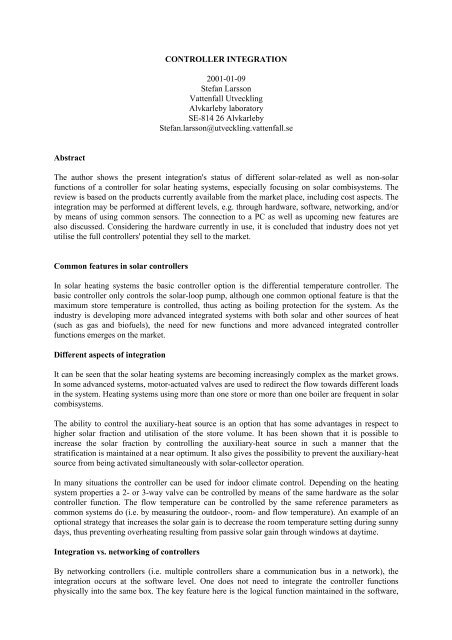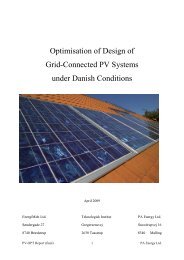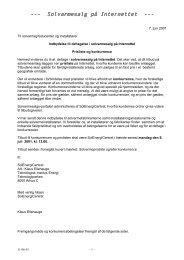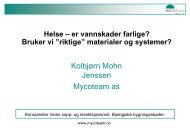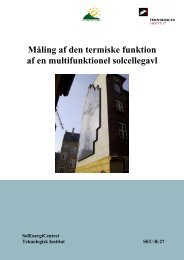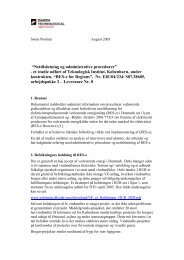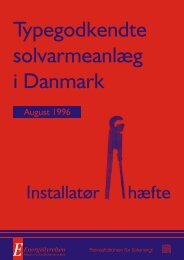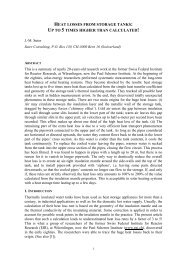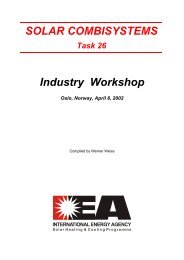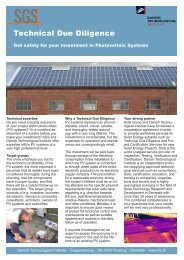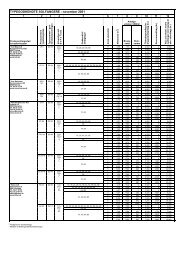Stefan Larsson: Controller integration - Solenergi.dk
Stefan Larsson: Controller integration - Solenergi.dk
Stefan Larsson: Controller integration - Solenergi.dk
Create successful ePaper yourself
Turn your PDF publications into a flip-book with our unique Google optimized e-Paper software.
CONTROLLER INTEGRATION<br />
2001-01-09<br />
<strong>Stefan</strong> <strong>Larsson</strong><br />
Vattenfall Utveckling<br />
Alvkarleby laboratory<br />
SE-814 26 Alvkarleby<br />
<strong>Stefan</strong>.larsson@utveckling.vattenfall.se<br />
Abstract<br />
The author shows the present <strong>integration</strong>'s status of different solar-related as well as non-solar<br />
functions of a controller for solar heating systems, especially focusing on solar combisystems. The<br />
review is based on the products currently available from the market place, including cost aspects. The<br />
<strong>integration</strong> may be performed at different levels, e.g. through hardware, software, networking, and/or<br />
by means of using common sensors. The connection to a PC as well as upcoming new features are<br />
also discussed. Considering the hardware currently in use, it is concluded that industry does not yet<br />
utilise the full controllers' potential they sell to the market.<br />
Common features in solar controllers<br />
In solar heating systems the basic controller option is the differential temperature controller. The<br />
basic controller only controls the solar-loop pump, although one common optional feature is that the<br />
maximum store temperature is controlled, thus acting as boiling protection for the system. As the<br />
industry is developing more advanced integrated systems with both solar and other sources of heat<br />
(such as gas and biofuels), the need for new functions and more advanced integrated controller<br />
functions emerges on the market.<br />
Different aspects of <strong>integration</strong><br />
It can be seen that the solar heating systems are becoming increasingly complex as the market grows.<br />
In some advanced systems, motor-actuated valves are used to redirect the flow towards different loads<br />
in the system. Heating systems using more than one store or more than one boiler are frequent in solar<br />
combisystems.<br />
The ability to control the auxiliary-heat source is an option that has some advantages in respect to<br />
higher solar fraction and utilisation of the store volume. It has been shown that it is possible to<br />
increase the solar fraction by controlling the auxiliary-heat source in such a manner that the<br />
stratification is maintained at a near optimum. It also gives the possibility to prevent the auxiliary-heat<br />
source from being activated simultaneously with solar-collector operation.<br />
In many situations the controller can be used for indoor climate control. Depending on the heating<br />
system properties a 2- or 3-way valve can be controlled by means of the same hardware as the solar<br />
controller function. The flow temperature can be controlled by the same reference parameters as<br />
common systems do (i.e. by measuring the outdoor-, room- and flow temperature). An example of an<br />
optional strategy that increases the solar gain is to decrease the room temperature setting during sunny<br />
days, thus preventing overheating resulting from passive solar gain through windows at daytime.<br />
Integration vs. networking of controllers<br />
By networking controllers (i.e. multiple controllers share a communication bus in a network), the<br />
<strong>integration</strong> occurs at the software level. One does not need to integrate the controller functions<br />
physically into the same box. The key feature here is the logical function maintained in the software,
thus making the system work as one single unit. The controller function can be divided into two or<br />
more separate parts, for example a solar-loop pump with internal controller operating networked with<br />
a boiler controller. This is common technology in large district heating systems but not in small<br />
domestic heating systems.<br />
Another issue in networking controller systems is the sensor. In this line of development, the industry<br />
is manufacturing intelligent sensors that can communicate over a simple serial bus network. One<br />
example is the I-Button from Dallas Semiconductor. These sensors use a communication protocol that<br />
only requires one single wire, and many sensors can share the same bus.<br />
Wireless sensors are also becoming more and more interesting as the cost decreases for local<br />
communication networks (i.e. inside the building or close to the building), but the cost is too high for<br />
most solar applications today.<br />
Remote operation of integrated controllers<br />
By means of new technology in information distribution, it is possible to control a solar heating<br />
system from remote locations. This makes possible to transfer weather data to the system with the aim<br />
of turning off the auxiliary heater and loading a reduced amount of auxiliary heat into the store if<br />
solar irradiation is predicted to be high. Such energy-efficient features have been demonstrated in the<br />
non-solar industry for climate control of buildings.<br />
User interface<br />
The only most costly part of the controller is neither the processor nor the sensor A/D converter, but<br />
the user interface. The user interface must give clear and stringent messages to the user and the<br />
available buttons must have a clear function, in order to prevent misinterpretations and misuses. But<br />
the high cost of the user interface forces the industry to use controllers with the simplest possible<br />
means to communicate with the user. Often simplified controller interface is the major cause of<br />
misinterpretations and user-caused malfunctions (the human factor).<br />
The most common controllers on the market today have a simple 3-4 numerical digit LED display and<br />
one push button or more for user input. By means of this interface, the user is able to monitor<br />
temperatures and settings. By introducing additional LEDs, one can give the user additional<br />
information in text labelled ”menus” to tell him which parameter is monitored or which function is<br />
currently selected. This is a low-cost design but it also means that the final product is only able to do<br />
its specific function and cannot be changed. One such example is showed in Figure 1.<br />
Figure 1. An example of an integrated<br />
controller for solar combisystems<br />
(courtesy Lartec AB, Sweden)<br />
At upper level, we see some more<br />
advanced systems that have alphanumerical<br />
LCD displays able to give more<br />
information ”in clear speech” to the user.<br />
This increases the ability to understand the<br />
information provided. By using a rotary<br />
knob instead of push buttons, the user can<br />
easily navigate through the different<br />
monitored values or settings. These designs<br />
are more flexible and only require a new programme or ”operating system” to change functions.
The most-advanced controller on the market today uses a graphic LCD display that has the ability to<br />
present diagrams and graphic elements to the user. Examples have been shown in which the user<br />
interface is presenting ”icons” on the display like a PC environment that the user can navigate<br />
through. It is also much easier to read a calendar function when it can be presented in a graphic<br />
layout.<br />
Today, more and more households have a PC. The establishment of a connection between a solar<br />
controller and the PC in respect to the user interface is a powerful tool because more information can<br />
be presented to the user. Most micro-controllers may be directly connected to a PC by using the serial<br />
RS232 port. Most today's PCs also have high tolerances in the required voltage levels so that there is<br />
no need for special RS232 voltage level interfaces or buffer circuits. Some examples of this feature<br />
have also been shown by the industry.<br />
Upcoming new features in integrated controllers<br />
In recent years, some steps have been taken to use the controller for monitoring the solar gain. One<br />
parameter easy to measure is the solar-loop pump operating time. Knowing the specific collector area,<br />
the operating time and an estimate of how many hours the pump should run at the location considered,<br />
the user can check if the system is working properly.<br />
More-advanced options could also be economically feasible today. By measuring the solar-loop flow<br />
rate, inlet/outlet and ambient temperatures, the hemispherical solar irradiance and the auxiliary energy<br />
supplied to the system, it is possible to calculate the efficiency during normal operation even in small<br />
domestic solar heating systems. Such features should increase the user’s ability to monitor the overall<br />
system efficiency and should also increase the quality of the systems currently available from the<br />
market place.<br />
The implementation of these new features is possible in some of the most common micro-controller<br />
processors used today by the industry. The main obstacle, however, is the implementation of<br />
advanced mathematical functions. The standard 8- to 14-bit RISC processor core used by Atmel,<br />
Microchip, Motorola, SGS-Thomson can only handle integer mathematics in small numbers up to 16-<br />
bit binary, i.e. numbers between 0 and 65535 in decimal. It is however possible to overcome such<br />
restrictions by developing ”operational systems” that translate or ”add” up to 32-bit floating point<br />
mathematical functions. By using such software strategy, mathematical models could be implemented<br />
directly into the microprocessor core. Some examples of embedded micro-controllers that have a<br />
software core to emulate ”floating point co-processor” have also been demonstrated. By implementing<br />
such hardware, one can use the mainstream controller as a combined control and a measuring and<br />
evaluation system with a co-processor hidden inside the box (i.e. the user does not need to be aware of<br />
the embedded system). This co-processor costs about USD 20-30 up to 32-bit arithmetic.<br />
As sensor technology is becoming less expensive, new features like solar-loop glycol condition<br />
analysis are made available. With simple pH sensors, the condition of the heat transfer fluid can be<br />
monitored. By using intelligent ”noses”, ultrasound or optical systems, one can analyse other<br />
properties in the fluid but at the penalty of higher system cost.<br />
At all, this also means that the industry does not utilise the full potential of the controllers they sell to<br />
the market, considering the hardware currently in use.


